Construction of oxygen vacancy-enriched manganese dioxide via liquid metal reduction for enhanced electrochemical performance
IF 4.4
3区 化学
Q1 CHEMISTRY, INORGANIC & NUCLEAR
引用次数: 0
Abstract
As a typical supercapacitor electrode material, manganese dioxide (MnO2) faces application challenges due to its inferior conductivity and specific capacitance, which falls significantly below its theoretical capacity. Herein, a novel method is proposed utilizing the reducibility of gallium-based liquid metal to modulate the oxygen vacancies of MnO2 under mild ambient conditions. The introduction of oxygen vacancies can effectively enhance the conductivity of MnO2 and create more electrochemical active sites, leading to improved charge storage capabilities. A specific capacitance of 327F g−1 is achieved at a current density of 1 A g−1 for oxygen vacancy-enriched MnO2 (24-MnOx), which is approximately 6 times that of pristine MnO2 (0-MnOx). The symmetric supercapacitor device assembled from 24-MnOx exhibits an energy density of 24 Wh kg−1 at a power density of 600 W kg−1. Density Functional Theory (DFT) simulations reveal that the introduction of oxygen vacancies enhances the electrical conductivity of 24-MnOx, and significantly promotes the diffusion of K+, leading to enhanced electrochemical performance. These results indicate that the reducibility of liquid metal can effectively modulate the oxygen vacancy concentration in MnO2, providing new insights for designing high-performance supercapacitor electrode materials.

液态金属还原法制备富氧二氧化锰以提高电化学性能
二氧化锰(MnO2)作为一种典型的超级电容器电极材料,由于其电导率和比电容较差,远远低于理论容量,因此在应用中面临挑战。本文提出了一种在温和环境条件下利用镓基液态金属的还原性来调节MnO2氧空位的新方法。引入氧空位可以有效地增强MnO2的电导率,并产生更多的电化学活性位点,从而提高电荷存储能力。富氧MnO2 (24-MnOx)在电流密度为1 A g−1时的比电容为327F g−1,约为原始MnO2 (0-MnOx)的6倍。由24- mnox组装的对称超级电容器器件在功率密度为600 W kg - 1的情况下,能量密度为24 Wh kg - 1。密度泛函理论(DFT)模拟表明,氧空位的引入提高了24-MnOx的电导率,并显著促进了K+的扩散,从而提高了电化学性能。这些结果表明,液态金属的还原性可以有效地调节MnO2中氧空位浓度,为设计高性能超级电容器电极材料提供了新的思路。
本文章由计算机程序翻译,如有差异,请以英文原文为准。
求助全文
约1分钟内获得全文
求助全文
来源期刊

Inorganic Chemistry Communications
化学-无机化学与核化学
CiteScore
5.50
自引率
7.90%
发文量
1013
审稿时长
53 days
期刊介绍:
Launched in January 1998, Inorganic Chemistry Communications is an international journal dedicated to the rapid publication of short communications in the major areas of inorganic, organometallic and supramolecular chemistry. Topics include synthetic and reaction chemistry, kinetics and mechanisms of reactions, bioinorganic chemistry, photochemistry and the use of metal and organometallic compounds in stoichiometric and catalytic synthesis or organic compounds.
 求助内容:
求助内容: 应助结果提醒方式:
应助结果提醒方式:


